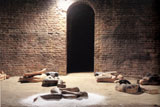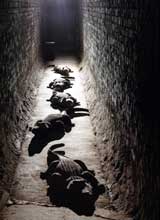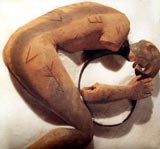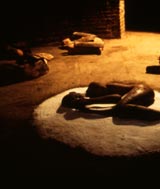| Paladino/Eno - 'I dormienti', 1999. Paladino/Eno at the Roundhouse Undercroft, London. 9 September- 6 October, 1999. This was the first time Italian artist Mimmo Paladino created a site-specific installation in London and it coincided with an exhibition of his sculpture at the South London Gallery. He combined the unique subterranean atmosphere of the Roundhouse undercroft, used as an art venue for the first time, with arrangements of his sculptures called I dormienti (the Sleepers). The undercroft is laid out like a spoked wheel, with arched brick tunnels radiating outwards from a central arena. Paladino collaborated with Brian Eno on the installation, whose work involved a complex montage of sound layers to coincide with the unusual acoustic properties of the space. The installation reflected the artists' common creative approach in that they both used repeated elements in random combinations whether it be accumulated layers of sound or form. Drawn towards its central nucleus the audience were allowed to enter and become an integral part of it. Paladino's installation combined two sculptural elements, the sleeping figure and the crocodile, that he had been developing over a number of years. He worked closely with a specialist ceramic works in Faenza where he could get involved directly with the casting process both before and after firing. Moulds allowed for the production of multiples, around eighty in total, that he could then individualize, sometimes breaking the figures into fragments and then reassembling and glazing them in various different colour combinations. The sleeping figures were distributed around the central space while the crocodiles occupied the long narrow passages. Paladino singled out one particular sleeping figure with an integral bowl which he filled with white rock-salt and its brightness formed a spotlight on the piece. He also made a series of spontaneous charcoal site-drawings, affixing each sketch at various intervals on the walls on the outer perimeter of the undercroft. The particular layout of the undercroft with its labyrinth of passages offered exciting acoustic possibilities for Brian Eno giving him an unprecedented opportunity to try out a number of ideas about mixing sounds in space that he has been working on for many years. This relates to an interest in the composition of music from several layers of sound moving independently of each other with each layer existing both in isolation and combining together. The shafts of the Undercroft with their wedge-shaped areas projected the sound like vast bass bins and in the central arena a mix of all the individual elements could be heard. He was able to create multiple independent sound sources by using ten portable CD players or beat-boxes. This configuration provided a spatial dimension beyond stereo so that the musical composition assumed the form of a 'sound sculpture'. A different CD was produced for each player each having between three and thirty tracks which represented a unique layer of sound. Using the players' control facility called random-shuffle, ever evolving and infinite permutations of sound were therefore possible. See also the publication: 'I Dormienti' - Brian Eno & Mimmo Paladino , texts by Demetrio Paparone & James Putnam, published by Alberico Cetti Serbelloni Editore, Milan, 2000. |
 |
||
| I dormienti, 1999 - installation view central area of undercroft. |
|||
 |
|||
| I dormienti, 1999 - installation in one of the undercroft
passages. |
|||
 |
|||
| I dormienti, 1999 - installation detail, sculpture and salt, central area of undercroft. |
|||
 |
|||
| I dormienti, 1999- installation view central area of
undercroft.
|
|||